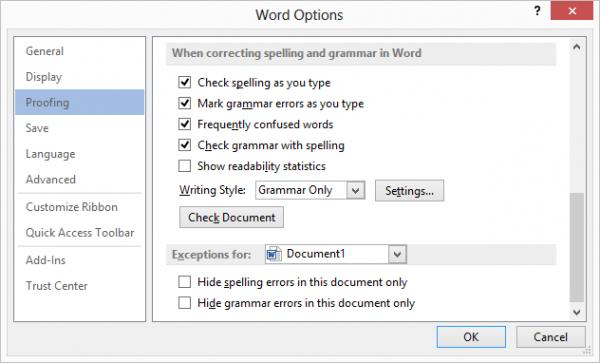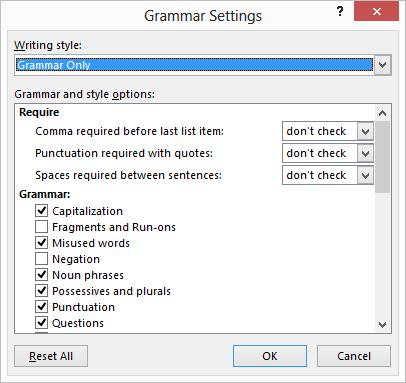Please Note: This article is written for users of the following Microsoft Word versions: 2007, 2010, 2013, and 2016. If you are using an earlier version (Word 2003 or earlier), this tip may not work for you. For a version of this tip written specifically for earlier versions of Word, click here: Changing How Word Flags Compound Words.
Written by Allen Wyatt (last updated August 18, 2022)
This tip applies to Word 2007, 2010, 2013, and 2016
Mark is having a problem with the spell checker and words that are connected with each other using a non-breaking hyphen. It seems that Word is flagging the words as incorrect, when it never flags them if the hyphen isn't there. Mark tried adding the words to the dictionary and tried telling Word to ignore the words, but they still get flagged.
There are two things to try. First, you can try these steps if you are using Word 2007, Word 2010, or Word 2013:

Figure 1. The Proofing options of the Word Options dialog box.

Figure 2. The Grammar Settings dialog box.
The above steps won't work in Word 2016 because the grammar and style options are greatly reduced in that version. You could, however, try the steps and turn off the Hyphenation option in step 5; that may work in some instances.
The other option is to try a workaround that some subscribers have reported as successful: Select the first word (the one before the hyphen) and add it to Word's exclusion list. (How you create and use exclusion lists has been examined in other issues of WordTips; doing a search for the phrase on the WordTips website will turn up several results.)
WordTips is your source for cost-effective Microsoft Word training. (Microsoft Word is the most popular word processing software in the world.) This tip (7351) applies to Microsoft Word 2007, 2010, 2013, and 2016. You can find a version of this tip for the older menu interface of Word here: Changing How Word Flags Compound Words.

Create Custom Apps with VBA! Discover how to extend the capabilities of Office 365 applications with VBA programming. Written in clear terms and understandable language, the book includes systematic tutorials and contains both intermediate and advanced content for experienced VB developers. Designed to be comprehensive, the book addresses not just one Office application, but the entire Office suite. Check out Mastering VBA for Microsoft Office 365 today!
Word provides handy spelling and grammar checkers. The grammar checker won't catch everything, however. One thing it ...
Discover MoreIf you find the green and red squiggly underlines that Word adds to your document distracting, you might want a quick way ...
Discover MoreWhen Word checks the grammar it thinks you are using in your prose, it follows a set of rules. Fortunately, the program ...
Discover MoreFREE SERVICE: Get tips like this every week in WordTips, a free productivity newsletter. Enter your address and click "Subscribe."
There are currently no comments for this tip. (Be the first to leave your comment—just use the simple form above!)
Got a version of Word that uses the ribbon interface (Word 2007 or later)? This site is for you! If you use an earlier version of Word, visit our WordTips site focusing on the menu interface.
Visit the WordTips channel on YouTube
FREE SERVICE: Get tips like this every week in WordTips, a free productivity newsletter. Enter your address and click "Subscribe."
Copyright © 2026 Sharon Parq Associates, Inc.
Comments